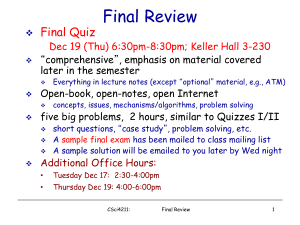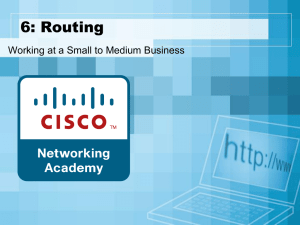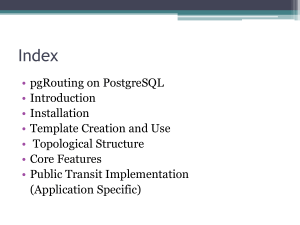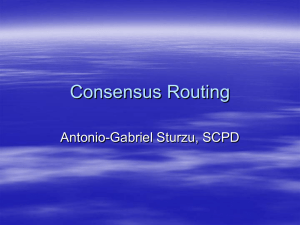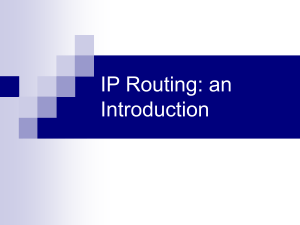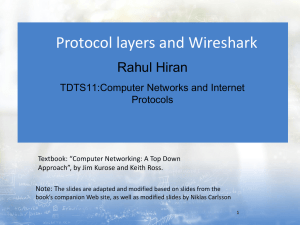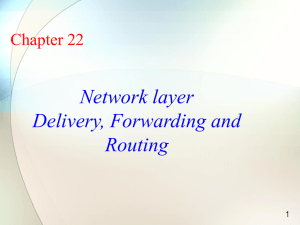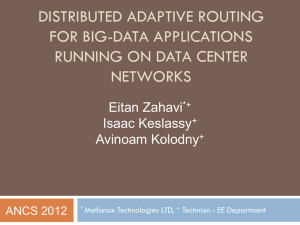Slides
advertisement
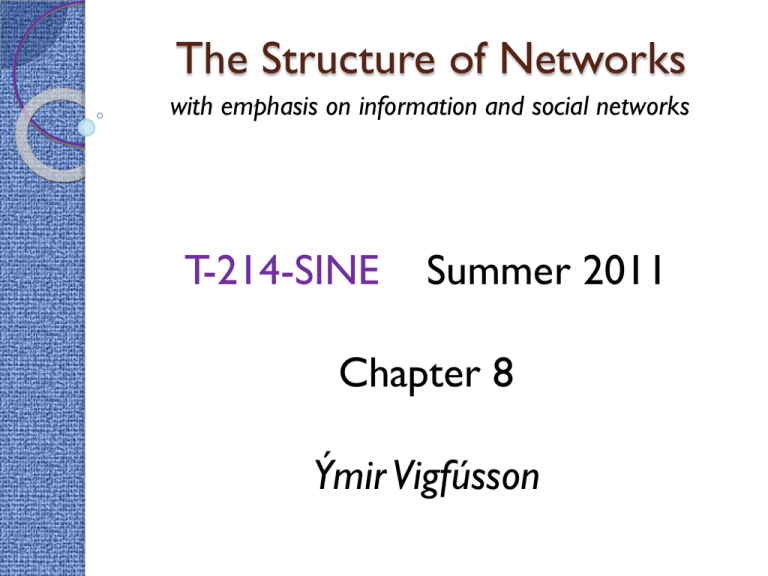
The Structure of Networks with emphasis on information and social networks T-214-SINE Summer 2011 Chapter 8 Ýmir Vigfússon Game theory in networks What we have discussed so far ◦ Network structure ◦ Regular game theory ◦ Evolutionary game theory Today we will combine game theory with networks ◦ Look at choosing a route in traffic ◦ Equivalently: network route for packets Abstraction Why should traffic be amenable to game theoretic reasoning? ◦ Individual don‘t choose routes in isolation ◦ They evaluate decisions of each another and reason about traffic congestion What will we learn? ◦ Adding capacity to a network can sometimes slow down the traffic! ◦ But it‘s never too bad Routing networks Traffic wants to flow from some source to some destination ◦ Here, the people at s want to drive to t Edges have latency or delay 𝑇𝑒 𝑥 = 𝑥/10 s t 𝑇𝑒´ 𝑥 = 1 ◦ Latency of upper edge e depends on how many choose it ◦ Latency of lower edge e‘ always 1 hour Routing games All players (drivers) are making private decisions about what path to drive ◦ We now have lots of players, not just two ◦ Each wants to minimize latency of the path This is the payoff Suppose 10 (100) commuters on the road What happens in the game? 𝑇𝑒 𝑥 = 𝑥/10 s t 𝑇𝑒´ 𝑥 = 1 Routing games Players have to reason about the latency of the upper edge ◦ „How many people do I think are driving there now?“ ◦ If too many, I‘ll take the lower edge ◦ This doesn‘t give a stable outcome More useful to ask: ◦ What is traffic like at Nash equilibrium? Another example Highway network, two routes. ◦ Latencies marked on the edges Suppose 4,000 cars go from A to B ◦ What will be the average travel time? Another example If everyone takes upper route ◦ 4000/100+45 = 85 minutes If everyone takes lower route ◦ 45+4000/100 = 85 minutes Another example But if they divide up evenly ◦ 2000/100+45 = 65 minutes What will happen at equilibrium? Another example Dividing up equally is a Nash equilibrium ◦ No driver has has an incentive to switch over to the other route This is the only Nash equilibrium ◦ Consider strategy where x drivers use upper route, and 4000-x use lower route ◦ If x is not 2000, then routes will have unequal travel time ◦ Thus users of slower route will want to switch to the faster route Therefore, x ≠2000 can‘t be a Nash equilibrium Braess‘s Paradox New amaizng highway is built from C to D What will happen at equilibrium? ◦ Everyone picks the A,C,D,B route! Braess‘s Paradox (see other slide set) Refresher: Internet Routing How do packets get from A to B in the Internet? Internet A B Connectionless Forwarding Each router (switch) makes a local decision to forward the packet towards B ◦ Does this mess up our game theory model? R1 R4 R7 R6 A R2 B R8 R3 R5 Connectionless Forwarding This process is termed destination-based connectionless forwarding How does each router know the correct local forwarding decision for any possible destination address? ◦ Through knowledge of the topology state of the network ◦ This knowledge is maintained by a routing protocol Routing Protocols Distribute the knowledge of the current topology state of the network to all routers This knowledge is used by each router to generate a forwarding table ◦ contains the local switching decision for each known destination address Routing Protocols Correct operation of the routing state of a network is essential for the management of a quality network service ◦ accuracy of the routing information ◦ dynamic adjustment of the routing information ◦ matching aggregate traffic flow to network capacity ISP Routing Tasks customers internal peer / upstream Exterior routing Interior routing Customer routing Interior Routing Protocols Interior Routing ◦ discovers the topology of a network through the operation of a distributed routing protocol Describe the current network topology Routing protocols distribute how to reach address prefix groups Routing protocols function through either ◦ distributed computing model (distance vector) ◦ parallel computing model (link state) Path Selection R1 R4 5 R7 40 45 5 10 20 A 5 6 R6 R2 B 10 4 15 10 R3 5 Minimum cost from A to B is 39 units R5 10 R8 Dynamic Path Adjustment R1 R4 5 R7 40 45 5 10 20 A 5 6 R6 R2 B 10 15 4 R3 5 R5 10 If R5 – R7 breaks, minimum cost path from A to B is Now 46 units R8 Routing Protocols Distance Vector Routing Protocols ◦ E.g. RIP protocol ◦ Each node sends its routing table (dest, distance) to all neighbors every 30 seconds ◦ Lower distances are updated with the neighbor as next hop cannot scale cannot resolve routing loops quickly Routing Protocols Link State Routing Protocols ◦ Each link, the connected nodes and the metric is flooded to all routers ◦ Each link up/down status change is incrementally flooded ◦ Each router re-computes the routing table in parallel using the common link state database ◦ OSPF is the main protocol in use today Take away Users at home have no say as to which of multiple routes their packets take ◦ Chosen entirely by routers But every router is making shortest-path decisions on behalf of all the packets it forwards ◦ Routers are thus not just reasoning locally So in practice, our game theory model works when we deal with ISP routers instead of home users ◦ Only a minor perceptual change! Summary of what we learned Routing games ◦ Regular/network traffic with game theory A new road can hurt performance at equilibrium ◦ Known as Braess‘s paradox Best response dynamics finds equilibrium ◦ Thm: Traffic at equilibrium is at worst twice as bad as optimal traffic (social optimum) Better bound: factor of 4/3 [Tardos,Roughgarden] Network traffic



